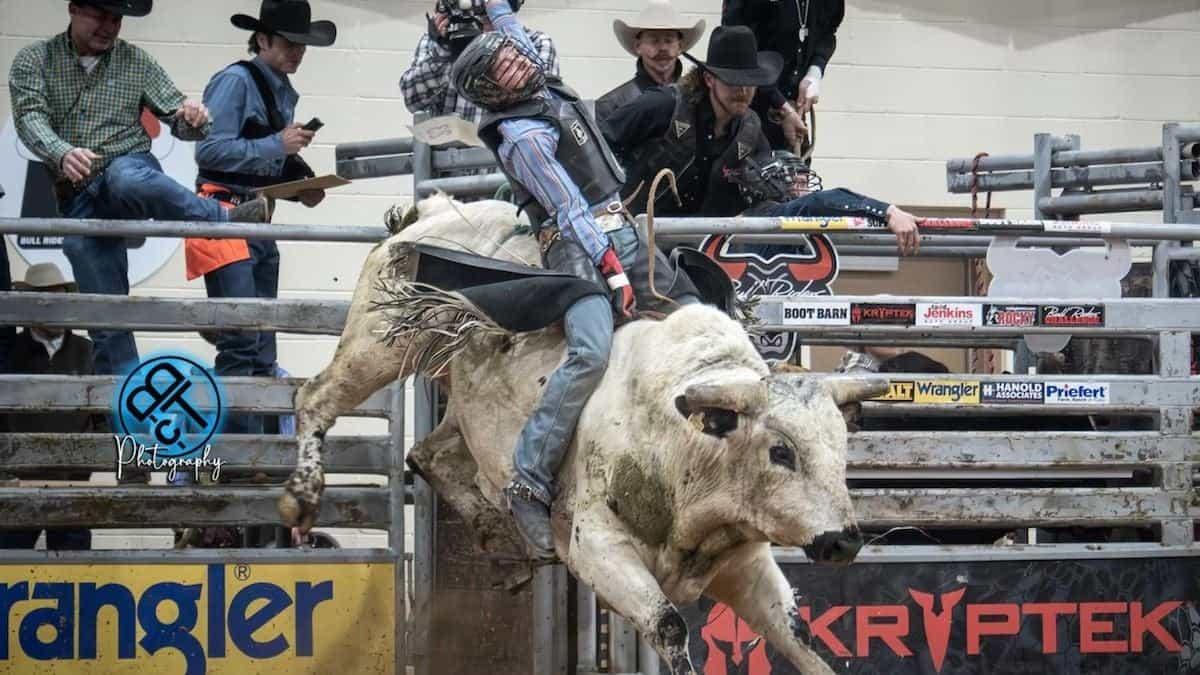Show table of content Hide table of content
A tragedy struck the Texas rodeo community last week when a promising young bull rider lost his life in a devastating accident. Dylan Grant, 25, died after being trampled by a 900-kilogram (2,000-pound) bull during a competition at the Wharton County Youth Fair. This heartbreaking incident has sent shockwaves through the rodeo world and raised questions about safety in this dangerous sport.
Tragic rodeo accident claims the life of promising rider
On Thursday, April 3, 2025, what started as a routine bull riding event at the Xtreme Bulls competition in Texas ended in tragedy. Dylan Grant, a rising star from Wyoming, was thrown from a massive bull weighing approximately 900 kilograms before being fatally trampled. Witnesses described the horrific scene as the powerful animal’s hooves struck the young rider, leaving him unconscious on the arena floor.
Emergency responders quickly transported Grant to a waiting ambulance. Due to the severity of his injuries, particularly a critical neck fracture, he was airlifted to a Houston hospital. Despite medical teams’ best efforts, the 25-year-old succumbed to his injuries. This incident highlights the extreme dangers faced by rodeo participants, similar to risks encountered in other animal-related activities where massive animals can pose significant threats to humans.
News This TikToker buys a used van and realizes it has a hidden surveillance device.
Robert Blue Jeanes, the event announcer, expressed profound grief when speaking to the Cowboy State Daily. “We are simply devastated. We are sad and heartbroken for the young man and his family,” he stated. These sentiments were echoed by the Wharton County Sheriff who offered prayers for Grant’s family and the entire rodeo community in a statement to ABC News.
The dangers behind bull riding competitions
Bull riding stands as one of the most hazardous sporting events in North America. When riders mount these powerful animals, they place themselves at tremendous risk. Professional bulls used in competitions are specifically bred for strength, agility, and unpredictable movement patterns. These animals typically weigh between 800 and 1,100 kilograms, making them formidable opponents for even the most skilled riders.
The Professional Rodeo Cowboys Association (PRCA) acknowledges these inherent risks while implementing safety protocols. In response to Grant’s death, the organization released a statement to the New York Post: “This is a very regrettable incident. The PRCA has procedures in place to review all incidents to ensure the safety of our participants and animals.” Despite these measures, the unpredictable nature of working with such powerful animals means accidents can never be completely eliminated.
Texas remains a stronghold for rodeo culture, where these events draw thousands of spectators yearly. However, the relationship between humans and animals in competitive settings continues to evolve, sometimes with troubling ethical questions about animal welfare and human safety. Unlike many animals that form natural bonds with their human companions, bulls in rodeo settings maintain their wild instincts.
Dylan Grant: A promising career cut short
Grant began his professional bull riding journey in 2018 and quickly established himself as an emerging talent in the field. Over his short but impactful career, he had accumulated more than $15,000 in competition earnings, demonstrating his skill and dedication to the sport. Friends and fellow competitors described him as passionate and determined, with a bright future ahead in the rodeo circuit.
Social media platforms have filled with tributes to the young rider. Photos shared by rodeo photographer Kendra Santos on Facebook show a talented athlete in his prime, now serving as painful reminders of a life cut tragically short. The rodeo community, known for its tight-knit relationships, has rallied around Grant’s family during this difficult time.
The strong connections formed within the rodeo world mirror the deep bonds that can develop between humans and animals, whether in competitive settings or in cases where pets and owners forge lasting relationships. Grant’s dedication to mastering his craft reflected the commitment often seen in those who work closely with animals.
The aftermath and safety conversations
As the rodeo community mourns Grant’s loss, questions remain about the bull involved in the fatal incident. Authorities have not yet announced any decisions regarding the animal’s future. This situation highlights the complex relationship between rodeo athletes and the powerful animals they compete with – a dynamic that balances tradition, sport, and risk.
News Bat wings after 50? Here’s the most effective exercise, according to a coach.
The tragedy has reignited discussions about safety measures in rodeo events. While protective gear like helmets and vests have become more common in recent years, the inherent dangers of bull riding persist. Some advocates call for enhanced safety requirements, while others argue that risk is an intrinsic part of the sport’s nature and appeal.
This devastating incident serves as a reminder of how quickly circumstances can change when working with unpredictable animals. Similar to how unexpected encounters with animals can transform lives, Grant’s story shows how quickly tragedy can strike in these high-risk scenarios.
As the rodeo season continues, Grant’s absence will be deeply felt throughout the circuit. His memory will likely inspire renewed commitment to safety protocols while preserving the traditions that make rodeo an iconic part of Western American culture. For now, the community continues to honor a young rider who died pursuing his passion, leaving behind a legacy of courage and determination in one of the world’s most dangerous sports.


